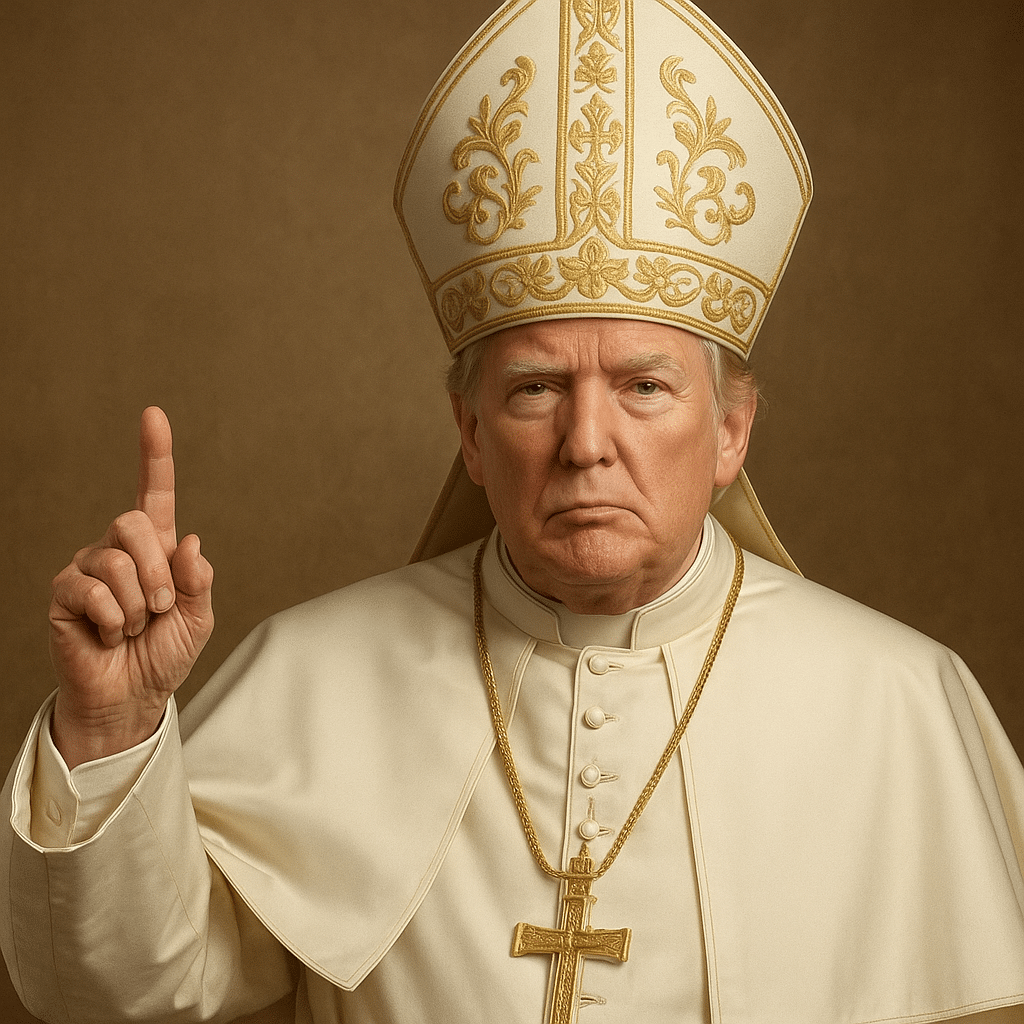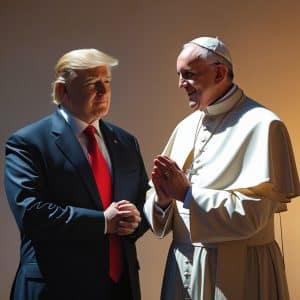
In a media moment that blurred satire, spectacle, and sacrilege, Donald J. Trump once again made global headlines—this time not as a former president but as a fictional Pope. The catalyst: an AI-generated image he shared of himself adorned in full papal regalia, posted just days after Pope Francis’s death. What began as an offhand joke quickly became a viral, controversial, and deeply polarizing conversation about politics, religion, and the power of digital media in shaping narratives.
“I’d Like to Be Pope”: It Started With a Joke
It began innocently enough—or so it seemed. When asked by reporters earlier in the week who he’d like to see succeed Pope Francis, Trump smiled and said, “I’d like to be pope. That would be my number one choice.” Delivered with characteristic bravado, the quip might have been forgotten had it not been for what followed.
On Saturday, Trump doubled down by sharing an image across Truth Social, Instagram, and X (formerly Twitter). The AI-rendered portrait depicted him in immaculate white papal vestments, a golden cross draped across his chest, and one finger raised in a solemn pose eerily reminiscent of classical Catholic iconography.
He offered no caption—just the image. But the statement it made needed none.

Digital Devotion or Disrespect?
The timing was nothing short of incendiary. Pope Francis had died just days earlier on Easter Monday, triggering a period of solemn mourning for millions of Catholics around the world. The Vatican was deep in preparations for the next papal conclave when Trump’s image began circulating like wildfire across platforms, amplified further by the official White House Instagram and X accounts, which reposted it without comment.
To some, the post was audacious political theater. To others, it was grotesquely disrespectful.
“It’s never appropriate to ridicule or mock the papacy,” said Dennis Poust, Executive Director of the New York State Catholic Conference. “It does cause offense.”
He continued: “There’s a long and painful history of anti-Catholic sentiment in the U.S., and something like this—even if meant as a joke—can reopen those wounds.”
Outrage—and Applause
Criticism came swiftly. Commenters on Truth Social called the post “sacrilegious,” “tasteless,” and “evidence of an unserious man.” Michael Steele, former RNC Chair, labeled it further proof that Trump is “incapable” of leadership, especially in sensitive cultural moments.
But not everyone was outraged.
Senator Lindsey Graham chimed in gleefully on X, quipping:
“I was excited to hear that President Trump is open to the idea of being the next Pope. The first Pope-U.S. President combo has many upsides. Watching for white smoke … Trump MMXXVIII!”
The humor landed with some conservatives as a cheeky counterpunch to what they see as a left-leaning media and clergy. Others saw it as another case of the Trump brand flexing its muscle—this time over sacred ground.
AI and the Age of Manufactured Reality
The episode also underscores a more urgent concern: the increasingly seamless—and powerful—role artificial intelligence plays in shaping political discourse.
This is not Trump’s first brush with controversial AI content. Earlier this year, he posted a video depicting a reimagined Gaza Strip as a glittering Trump-branded resort—an image that sparked outrage across the Middle East.
In this case, the papal image was so convincing that many questioned whether it was real. But therein lies the danger. As AI-generated media becomes more refined, the line between satire and misinformation becomes harder to detect.
With over 6 million views and climbing, the “Pope Trump” image may well become one of 2025’s most enduring memes—whether the former president intended it to or not.
Trump’s Religious Calculus
While Trump has often leaned into evangelical support, his relationship with the Catholic Church has been more complicated. He has previously praised figures like Cardinal Timothy Dolan of New York, whom he recently named as a “favorite” candidate for pope, though Dolan is not among the likely front-runners.
Though he has expanded the influence of conservative Christians in American politics, critics argue that his religious gestures often feel performative rather than pious. The “Pope Trump” moment, some say, only reinforces that belief.
Yet it may also be a strategic move. By placing himself—literally—in the robes of the pontiff, Trump is not just trolling the left or mocking sacred traditions. He’s positioning himself, once again, as the center of the cultural storm.
The Vatican’s Silence Speaks Volumes
At the time of publication, the Vatican has not issued an official response to Trump’s post. But behind the guarded silence, one can imagine a diplomatic sigh.
The Catholic Church, deeply entrenched in the solemn proceedings of the papal conclave, may have no appetite for political sideshows—especially one featuring a twice-impeached U.S. president moonlighting as a religious figurehead.
The Takeaway: Satire, Power, and the Trump Effect
Whether one sees the image as satire, sacrilege, or simply another viral moment in the never-ending Trump show, it holds a mirror up to our times.
We live in an era where a joke can upend a global news cycle, where AI can manufacture alternate realities in seconds, and where a man who once held the nuclear codes can post himself as the leader of the Catholic world and spark a theological debate.
And perhaps that is the real story: not just of Trump, not just of the Pope, but of a society reckoning with how power, image, and influence collide in the digital age.

